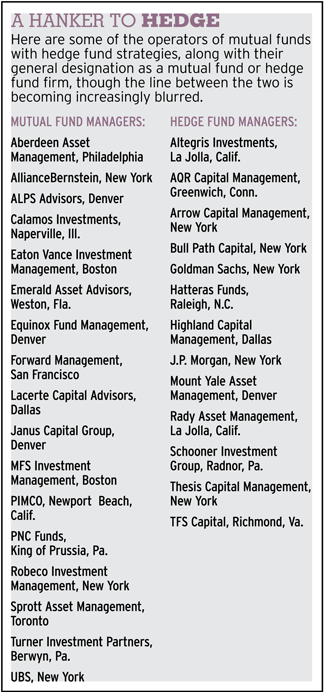3 Reasons to Go From Hedge to Mutual Fund
Post on: 14 Апрель, 2015 No Comment

One portfolio manager explains the thinking and strategy behind such a move
Tweaking an investment strategy may help advisor and clients alike.
Its a fair question: Why would a hedge fund manager trade the relative investment and operational freedom not to mention the potential fee income of that investment format for the constraints of a 40 Act mutual fund?
There are numerous differences between the formats to consider. Mutual funds must limit their investments in illiquid securities and cannot invest more than 25% of a funds assets in a single issue, unless the funds investment policy allows concentration. Leverage is capped; the fund must hire independent directors and use a third-party custodian.
Hedge funds use two methods to enter the mutual funds business. One is to launch a new mutual fund and hire a hedge fund manager to replicate his or her strategy within the mutual fund.
The other approach is to convert an existing hedge fund. This involves setting up the organization and redeeming limited partnership interests for shares in the new fund (or cashing out partners who dont want to continue with the new fund).
Hedge funds operating investment strategies in line with the 40 Acts restrictions are better suited for conversion. Examples include currency and managed futures, global macro, long/short equity and market neutral.
According to Victor Viner, founder and chief investment officer of V2 Capital LLC in Glenview, Illinois, converting his firms hedge fund to a 40 Act Fund on Oct. 31, 2014, was pretty much an easy business decision.
The conversion moved $240 million of assets, making it the largest hedged equity mutual fund launch of the year, according to the firm.
Here’s why Viner made the switch.
One: Broader Appeal
The hedge fund had a $5 million minimum and the V2 Hedged Equity Fund (VVHIX ) has a $1,000 minimum: That lower minimum exposes the fund to a much broader market of potential investors, even though the firm gives up its chance to earn performance fees.
The fund follows a long/short strategy that combines a long concentrated portfolio of 30 to 50 U.S. equities with a short portfolio of customized S&P 500 options.
Viner says the objective is to generate alpha on both sides and to keep to a net exposure that is between 20 and 80 and averages in the low 50s.

Two: An Easy Move
That strategy facilitated the conversion, says Viner: Whats nice from our perspective is we didnt have to change anything were doing. Weve been managing the same strategy, we use liquid instruments, we dont use leverage. So, we qualify for a 40 Act fund without any deviation from what weve been doing.
Third: Performance Profile
Because the portfolio essentially carried over from the hedge fund, the mutual fund can cite the hedge funds performance record from the first trading date of April 1, 2012.
The annualized return since inception through Oct. 31, 2014 is 8.75% vs. 5.82% for Morningstars Long/Short category. The funds stats versus the S&P 500 also compare well: beta: 0.52; R-squared: 0.53; annualized volatility of 6.63%; and a Sharpe Ratio of 1.26.
Viner views the fund as a core portfolio holding.
This should be a proxy for equity exposure, he says. Just because were hedging out some of the short side, some of the market exposure throughout a market cycle, we believe its just a smarter way to get equity exposure because you eliminate a lot of the volatility .














